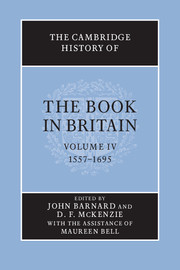Book contents
- Frontmatter
- Dedication
- Contents
- List of illustrations
- List of contributors
- Preface
- Acknowledgements
- Introduction
- RELIGION AND POLITICS
- ORAL TRADITIONS AND SCRIBAL CULTURE
- LITERATURE OF THE LEARNED
- LITERARY CANONS
- VERNACULAR TRADITIONS
- THE BUSINESS OF PRINT AND THE SPACE OF READING
- 26 Printing and publishing 1557–1700: constraints on the London book trades
- 27 The economic context
- 28 French paper in English books
- 29 The old English letter foundries
- 30 Bookbinding
- 31 Mise-en-page, illustration, expressive form
- BEYOND LONDON: PRODUCTION, DISTRIBUTION, RECEPTION
- DISRUPTION AND RESTRUCTURING: THE LATE SEVENTEENTH-CENTURY BOOK TRADE
- STATISTICAL APPENDICES
- Abbreviations
- Bibliography
- Index
- Plate Section
- References
27 - The economic context
from THE BUSINESS OF PRINT AND THE SPACE OF READING
- Frontmatter
- Dedication
- Contents
- List of illustrations
- List of contributors
- Preface
- Acknowledgements
- Introduction
- RELIGION AND POLITICS
- ORAL TRADITIONS AND SCRIBAL CULTURE
- LITERATURE OF THE LEARNED
- LITERARY CANONS
- VERNACULAR TRADITIONS
- THE BUSINESS OF PRINT AND THE SPACE OF READING
- 26 Printing and publishing 1557–1700: constraints on the London book trades
- 27 The economic context
- 28 French paper in English books
- 29 The old English letter foundries
- 30 Bookbinding
- 31 Mise-en-page, illustration, expressive form
- BEYOND LONDON: PRODUCTION, DISTRIBUTION, RECEPTION
- DISRUPTION AND RESTRUCTURING: THE LATE SEVENTEENTH-CENTURY BOOK TRADE
- STATISTICAL APPENDICES
- Abbreviations
- Bibliography
- Index
- Plate Section
- References
Summary
Many structural features of the early modern economy governed the working practices of the book trade. Diversity and interconnectedness marked the broader economic structure of publication and bookselling, of capitalization, productive capacity, of supplies of paper and other materials, of demand, of distribution and of trade regulation. The history of publication and its patronage ultimately begins and ends with the resources of the land and its population as a whole and, deriving from this, the wealth of particular individuals. Beyond these basic economic factors, the responses of the different crafts to the changes in economic conditions and to the changing profiles of the market were also affected by the cultural, religious and political cast of the practitioners themselves.
Publishing was driven by two economic incentives during this 140-year period: first, by the obvious possibility of immediate returns on work in hand, and second (and increasingly by the late seventeenth century), by investment opportunity. Crucial in both cases was the source of the capital to set up the business and to sustain it, and added to the early scarcity of venture funds, the difficulties in raising and managing credit heightened the importance of cash flow and steady turn-over. Even where publication can be considered as a form of speculation, the rate of sale of the products remained a primary determinant in the economic development of book and allied trades. Shared operations also became the most obvious form of risk limitation, especially where profitability was threatened by excess productive capacity.
Keywords
- Type
- Chapter
- Information
- The Cambridge History of the Book in Britain , pp. 568 - 582Publisher: Cambridge University PressPrint publication year: 2002
References
- 3
- Cited by



